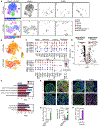Single-Cell Transcriptome Profiling Reveals β Cell Maturation in Stem Cell-Derived Islets after Transplantation
- PMID: 32846125
- PMCID: PMC7491368
- DOI: 10.1016/j.celrep.2020.108067
Single-Cell Transcriptome Profiling Reveals β Cell Maturation in Stem Cell-Derived Islets after Transplantation
Erratum in
-
Single-cell transcriptome profiling reveals β cell maturation in stem cell-derived islets after transplantation.Cell Rep. 2021 Mar 9;34(10):108850. doi: 10.1016/j.celrep.2021.108850. Cell Rep. 2021. PMID: 33691098 Free PMC article. No abstract available.
Abstract
Human pluripotent stem cells differentiated to insulin-secreting β cells (SC-β cells) in islet organoids could provide an unlimited cell source for diabetes cell replacement therapy. However, current SC-β cells generated in vitro are transcriptionally and functionally immature compared to native adult β cells. Here, we use single-cell transcriptomic profiling to catalog changes that occur in transplanted SC-β cells. We find that transplanted SC-β cells exhibit drastic transcriptional changes and mature to more closely resemble adult β cells. Insulin and IAPP protein secretions increase upon transplantation, along with expression of maturation genes lacking with differentiation in vitro, including INS, MAFA, CHGB, and G6PC2. Other differentiated cell types, such as SC-α and SC-enterochromaffin (SC-EC) cells, also exhibit large transcriptional changes. This study provides a comprehensive resource for understanding human islet cell maturation and provides important insights into maturation of SC-β cells and other SC-islet cell types to enable future differentiation strategy improvements.
Keywords: IAPP; alpha cells; beta cells; diabetes; insulin; islets; sngle-cell RNA sequencing; stem cells; transcriptome.
Copyright © 2020 The Authors. Published by Elsevier Inc. All rights reserved.
Conflict of interest statement
Declaration of Interests L.V.-C. and J.R.M. are inventors on patent applications related to SC-β cell technology described in this manuscript.
Figures






Comment in
-
Transplantation of stem cell-derived pancreatic islet cells.Nat Rev Endocrinol. 2021 Jan;17(1):7-8. doi: 10.1038/s41574-020-00430-9. Nat Rev Endocrinol. 2021. PMID: 33087845 No abstract available.
References
-
- Aguayo-Mazzucato C, and Bonner-Weir S (2010). Stem cell therapy for type 1 diabetes mellitus. Nat. Rev. Endocrinol 6, 139–148. - PubMed
Publication types
MeSH terms
Grants and funding
LinkOut - more resources
Full Text Sources
Other Literature Sources
Medical
Molecular Biology Databases
Miscellaneous

